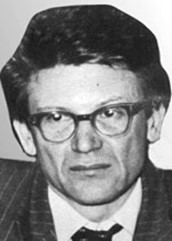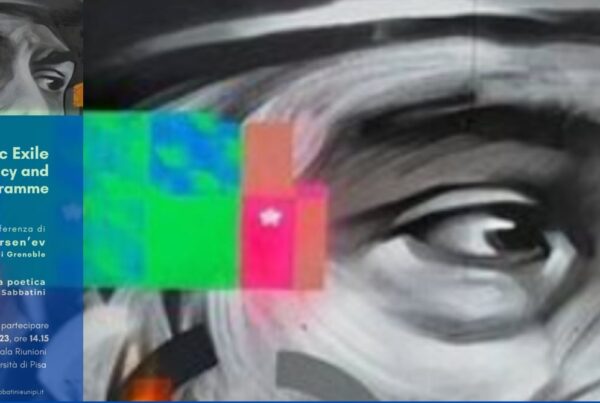
“If in response to ideas […], the regime is left with nothing else to do but lock people up in psychiatric hospitals, then this is a symptom peculiar to our time” – Andrei Amal’rik
(Artemova-Rar-Slavinski 1971: 414).
Andrei Alekseevich Amal’rik was an historian, art critic, campaigner and dramatist, who became one of the most important figures of dissent in the Soviet Union (cf. Clementi 2007:129). He took part in the Russian democratic movement (demokraticheskoe dvizhenie) and fought for the defence of intellectual freedom and human rights (cf. Keep 1971: 335).
He was born in 1938 in Moscow, son of the well-known historian and archaeologist Alexei Sergeievich Amal’rik and his wife Zoia Grigor’evna (cf. Polit.ru). The experience of his father, who was prevented from attending the Academy and pursuing his historical studies because of his compromised political past, played a decisive role in the life choices of the young Andrei Amal’rik (cf. Keep 1971: 336). He attended the Faculty of History at Moscow University from 1959 to 1963 (cf. Clementi 2007: 129), when he was expelled because of a paper in which he defended the so-called ‘norman theory’ (normanskaia teoriia) on the birth of the Russian state, which was rejected by Soviet scientific authorities (cf. Zubarev-Kuzovkin). The KGB claimed that Amal’rik was expelled from the university because of his unsatisfactory results, numerous absences and lack of commitment to his studies and because he had sold several of his father’s paintings to foreigners, as well as several others by non-conformist painter friends (cf. Clementi 2007: 150). Indeed, in addition to his literary production, work as an historian and commitment to the defence of human rights, Andrei Amal’rik collected art by avant-garde artists (cf. Tolstoi-Gavrilov 2011), which enabled him to have his first contacts with foreign diplomats and journalists (cf. Zubarev-Kuzovkin). Amal’rik’s work circulated in samizdat from 1953 (cf. Polit.ru). On 14th May 1965 he was arrested on charges of leading an “anti-social” lifestyle and sentenced to two and a half years’ internal exile in Tomsk, Siberia, but in 1966 the Supreme Court of the RSFSR reviewed his case and he was released (cf. ibid.).
Amal’rik wrote about this experience in Nezhelannoe puteshestvie v Sibir’ (Involuntary Journey to Siberia, 1970) (cf. Clementi 2007: 129) in which he criticises the Soviet judicial and penitentiary system, observing that structural inefficiencies inevitably lead to the failure of justice and the hoped-for effectiveness of the penitentiary “educational” model, generating fear in the population and a widespread distrust in institutions (cf. Keep 1971: 337). The book circulated in the USSR in samizdat and was then published abroad.
Following the annulment of his criminal sentence, Amal’rik returned to Moscow where he was employed as a theatre and art critic by the Novosti news agency (cf. Clementi, 2007: 129). In the period between 1966 and 1969, he became one of the leading figures of dissent and, thanks to his charisma and knowledge of English, he managed to maintain numerous contacts with foreign correspondents stationed in Moscow, defining himself as a kind of ‘liaison officer’ between dissident circles and foreign journalists (cf. Zubarev-Kuzovkin).
His contact with Western journalists led him to reflect on the limiting conditions experienced by journalists working in the USSR, and in 1970 he wrote an article entitled Inostrannye korrespondenty v Moskve (Foreign Correspondents in Moscow), an investigation into the legal status of representatives of foreign media in the Soviet Union in which he illustrates the ways in which they are hindered in their work (cf. Zubarev-Kuzovkin). The article, like much of his writing, circulated in the samizdat and it should be noted that he also promoted the circulation of other writers through the Soviet underground circuits. Amal’rik was responsible for the dissemination of numerous typescripts, including Vsë techët (Everything is Flowing, 1970) by V. Grossman, Moi pokazania (My Testimony, 1969) by A. Marchenko, many verses by I. Brodskii (cf. Clementi, 2007: 129) and A. Sakharov‘s book Razmyshleniia o progresse, mirnom sosushchestvovanii i intellectual’noi svobode (Reflections on progress, peaceful coexistence and intellectual freedom, 1969).
Together with Pavel Litvinov, Amal’rik collaborated on the white paper Protsess chetyrëkh (The Trial of the Four, 1968), on the trial of the defendants A. Ginzburg, Juhao Gorbachev, V. Lashkova and A. Dobrovol’skij, accused of producing and spreading of anti-Soviet works, including the White Book on the Siniavskii-Daniel’ case (cf. Polit.ru). After Litvinov’s arrest, Amal’rik finished the paper on his own, handing it to foreign correspondents in October of the same year. At the end of 1968, because of his activism, Amal’rik was dismissed from the Novosti news agency and found a job as a postman (cf. Zubarev-Kuzovkin).
Amal’rik’s non-fiction includes an important work dated 1969 Prosushchestvuet li Sovetskii Soiuz do 1984 goda? (Will the Soviet Union Survive Until 1984?), in which the author prophesied the inevitable dissolution of the USSR and sketched out a gloomy post-Soviet future without hope of democratic reform (cf. ibid.; Clementi 2007: 130). The book was published in Russian in the same year in tamizdat by the Dutch publishing house Alexander Herzen Foundation and later translated into numerous languages, including Italian (cf. Amal’rik 1970a), bringing its author great international fame and criticism at home, not only in the official Soviet press, but also in the samizdat circuit (cf. Zubarev-Kuzovkin). After the publication of this work abroad, the clandestine dissemination of his writing in the USSR and interviews to foreign journalists, Amal’rik’s flat was searched twice and it became evident that the police were preparing a new ‘case’ against him (cf. Keep 1971: 339). On 21st May 1970 he was arrested for the second time on charges of spreading false and slanderous information defaming the Soviet state, in accordance with paragraph 1 of Article 190 of the Soviet Criminal Code that came into force in 1966 (cf. Zubarev-Kuzovkin). In order to avoid the trial taking place in Moscow under the eyes of foreign correspondents and Soviet activists, a few days after his arrest Amal’rik was transferred to Sverdlosk, present-day Ekaterinburg, where the trial against him took place (cf. Clementi 2007: 134). These precautions, however, did not quell the protests and appeals for his release: Esenin-Vol’pin, V. Bukovskii, Iu. Vishnevskaia, P. Iakir and other Soviet human rights activists appealed to the UN for his release and 64 French historians sent a letter to the USSR Academy of Sciences expressing concern about their colleague’s arrest (cf. ibid.). The trial took place on 11th November 1970, but Amal’rik refused to take part and gave the judge a written note in which he declared that he did not consider the content of his writings to be defamatory and that they could not “under any circumstances be the subject of criminal proceedings” (ibid.: 135). He also reminded the court that, because of Article 125 of the Soviet Constitution and the Universal Declaration of Human Rights, both of which provide for freedom of expression, any such lawsuit was itself a crime against human rights and Soviet law. At the final hearing he gave his defense, comparing the proceedings against him to a witch trial, pointing out that if the fight against heresy could be explained by religious fanaticism, in his case (and that of many other Soviet dissidents) the reason for persecution was the government’s fear of those with ideas contrary to dominant thought and state ideology (cf. ibid.). Amal’rik reaffirmed that the process of emancipation of ideas now underway in the USSR was irreversible and would inevitably lead to the end of the regime (cf. ibid.): “The opinions I have expressed will not become less true if I am imprisoned because of them for several years. On the contrary, this can only give more strength to my convictions […] Neither the “witch hunt” conducted by the regime, nor its single example – this trial – arouse in me the slightest respect or even fear. I understand, however, that such tribunals are set up to frighten many, and many will be frightened, yet I think that the process of ideological emancipation which has now begun is irreversible” (Amal’rik 1970b).
Having been sentenced to three years of hard labour, Amal’rik served his term in the Novosibirsk and Magadan regions, at the end of which, on 21st May 1973, a new case was brought against him in accordance with the same article. He was sentenced again to a further three years’ imprisonment under a harsh regime, but thanks to national and international protests and Amal’rik’s own 117-day hunger strike, his sentence was commuted to three years’ internal exile in Magadan (cf. Zubarev-Kuzovkin). In 1974 he was awarded the Freedom Prize by the Freedom House organisation and the following year he returned once again to Moscow (cf. ibid.; Clementi 2007: 136).
In July 1976 he emigrated with his wife to the Netherlands, and in the same year he received an award from the International League for the Defence of Human Rights (cf. ibid.). During his years in exile, Amal’rik did not abandon his activity as a campaigner, collaborating with various journals and newspapers on Russian emigration – including the Parisian “Kontinent” and “Sintaksis” – and continuing to write essays, including Zapiski dissidenta (Notes of a dissident) (cf. ibid.). In spite of his exile, Amalrik also continued his struggle for human rights in the USSR until he was killed in 1980 in a car accident, while he was travelling to Madrid to take part in a conference organized with the aim of revising the Helsinki Accords (1975) with his wife – Giuzel’ Makudinova – and dissidents and human rights activists V. Borisov and V. Fainberg. The possibility of the Soviet Union’s compliance with the human rights directives of the Accords was far from certain, but Amalrik would have made his voice heard (cf. Austin 1982). He was buried in Paris, in the cemetery of Saint-Geneviève-des-Bois (cf. Zubarev-Kuzovnik).
Martina Benedetti
[30th June 2021]
Translation by Cecilia Martino
This article was produced as a result of the seminar “Civil Rights Movement in the USSR”, held by Ilaria Sicari (Course of Russian Literature, Master’s Degree in Euro-American Languages and Literatures, University of Florence, a.y. 2019-2020).
Bibliography
- Amal’rik A., Sopravviverà l’Unione Sovietica fino al 1984?, Coines Edizioni, Roma 1970a, http://www.maldura.unipd.it/samizdat/italia/pdf/amalrik1.pdf, online (last accessed: 30/06/2021).
- Amal’rik A., Poslednee slovo A. Amal’rika, “Chronika tekuščich sobytij”, 17 (1970b), http://hts.memo.ru/, online (last accessed: 30/06/2021).
- Artemova, A., Rar L., Slavinskii M., Kaznimye sumashestviem, Possev-Verlag, Frankfurt 1971.
- Austin A., The Life of a Zek, “The New York Times”, 11/07/1982, https://www.nytimes.com/1982/07/11/books/the-life-of-a-zek.html, online (last accessed: 30/06/2021).
- Clementi M., Storia del dissenso sovietico (1953-1991), Odradek, Roma 2007.
- Keep J., Andrei Amal’rik and ‘1984’, “Russian Review”, 30.4 (1971): 335-345.
- Polit.ru, Andrei Amal’rik, “Polit.ru”, https://polit.ru/news/2020/05/12/amalrik/, online (last accessed: 30/06/2021).
- Tolstoi I., Gavrilov A., Andrei Amal’rik, “Alfavit inakomysliia”, 23/02/2011, https://www.svoboda.org/a/2318407.html, online (last accessed: 30/06/2021).
- Zubarev D., Kuzovkin G., Amal’rik Andrei Alekseevich, “Chronos”, http://www.hrono.ru/biograf/bio_a/amalrik.html, online (last accessed: 30/06/2021).
To cite this article:
Martina Benedetti, Andrei Amal’rik, in Voci libere in URSS. Letteratura, pensiero, arti indipendenti in Unione Sovietica e gli echi in Occidente (1953-1991), a cura di C. Pieralli, M. Sabbatini, Firenze University Press, Firenze 2021-, <vocilibereurss.fupress.net>.
eISBN 978-88-5518-463-2
© 2021 Author(s)
Content license: CC BY 4.0




